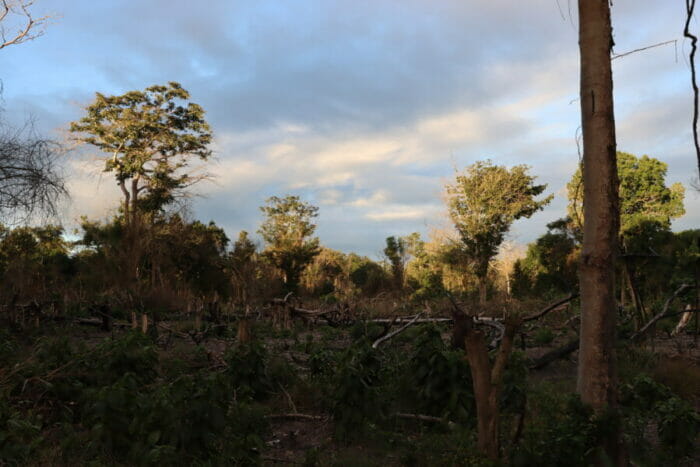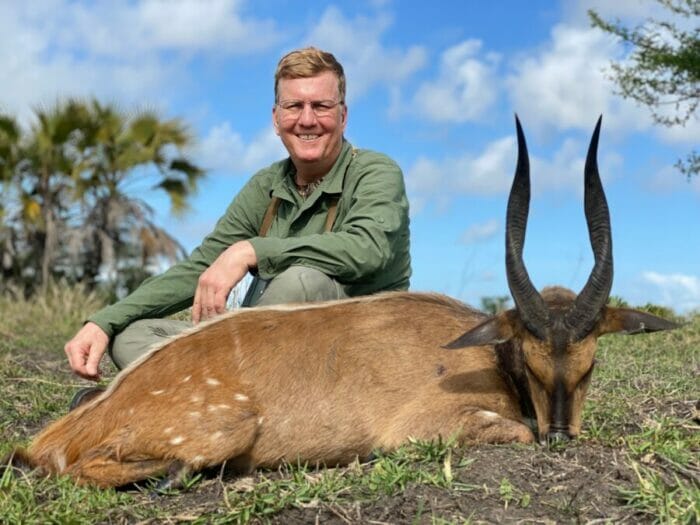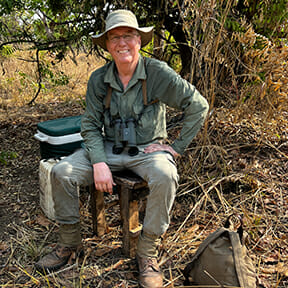The Plight of the Bushbuck: Losing By Conserving?
“Why do you call them ‘Nyala Gardens,’ Julian?” My PH smiled and said, “You’ll see.” Later, as I crouched next to Julian and our two Sena Trackers, Fernando, and Dolish, watching the Nyala bull, cow, and their two ‘kids,’ a new calf and a yearling, I started to get it. We had already stalked past 20 some odd of these beautiful antelopes, mostly cows and their calves, but also beautiful bulls with the magnificent orange legs, gray-brown bodies, vertical white side stripes from belly-to-backline, long snow-white dorsal crests, lovely bell-shaped horns ending in ivory tips. None of the bulls seen measured up to Julian’s standards – 28 inches or better along the outside curve of the spiral horn – but I didn’t mind the lack of a shot. It was breathtaking to be in the presence of so many Nyalas, some not more than 10 yards from where we crouched with binoculars raised to our eyes. I didn’t want the hunt to end.
We never did find a Nyala trophy in a Nyala Garden, satisfying my PH’s strict requirements. But the Gardens always had tens to hundreds of their namesakes, feeding through the clearings, browsing on the branches of shrubs and trees, and, when we weren’t careful enough in our movements, rocketing through open spaces and disappearing into the forested margins. As we drove away from this first of my Nyala Garden experiences, I mentioned to Julian that I was surprised we had not seen the other spiral-horned species that preferred the same type of habitat, Chobe Bushbucks. Julian stated flatly, “The Nyalas are much better competitors, and the Bushbuck numbers are way down.” We did see or hear the alarm bark from, the occasional Bushbuck while creeping through the Gardens, but those were rare encounters compared to the herds of Nyalas.
A very real overpopulation problem is occurring in the Ndumu Game Reserve in KwaZulu-Natal, South Africa, where one species of antelope, the Nyala, is crowding out another species, the Bushbuck. (Fay and Greeff, Nyala and Bushbuck I: A Competing Species Model)
Bushbuck in Decline
OK, I’ll admit to being skeptical about Nyalas causing declines in Coutada 11’s Chobe Bushbuck populations. To my eye, this was a tropical paradise with food enough for all the browsers and grazers. As a scientist, I knew better than to fall into the logical, intuitive trap set by my ignorance. I fell in anyway. The only way out was to observe Coutada 11, survey more PHs and scientists working in the concession, and dig into the scientific and wildlife management literature. Before you despair, I’m not going to recite tons of undigested data, but there are some cool observations that even scientists occasionally stumble over and report. Trust me, I’m a professional scientist and know what I speak – often, we must stumble over interesting findings before seeing them…
Professional Hunter Dylan Holmes provided the next brick in the wall of my education about the impact of Nyala overpopulation. The instruction came on my second Safari in Coutada 11. Dylan and I were not hunting Nyalas but instead searched for one of the Chobe Bushbuck rams. The rams possess beautiful red-brown hides dotted with white markings on rumps and a Nyala-like crest of long cream-colored hairs running from tail to neck.
Driving across one of the many open Pans, my PH pointed to the edge of the rapidly approaching forest. I thought Dylan was trying to get me to see an animal, but that was not the case. Pointing, he asked, “Do you see how all the trees are bare of leaves up to about the head height of a very tall person?” With that, I stopped squinting into the shadows, looking for an animal shape, instead broadening my gaze to take in the tree line. Sure enough, each tree and large bush looked like someone had gone through with electric hedge clippers, leaving a horizontal line of vegetation beginning at about 7 feet off the ground.
I hazarded a guess, “Nyalas?”
Once at the forest edge, Dylan nodded and stopped the Land Cruiser to let me look more closely at the browse line. The trees weren’t just missing a few leaves; the lower branches were completely bare.
“Our Bushbucks are in trouble from all the Nyalas. It’s not that adult Bushbucks can’t reach nearly as high into the trees as a Nyala; they don’t get to the browse before the greater numbers of Nyalas strip it clean.”
The addition of an exclamation point to this lesson happened as we rounded the curve into the forest; a cow, Nyala, stood at attention, flanked by three generations of calves and a mature bull.
OK, so I guess the identical opinions of two very knowledgeable PHs with decades of experience in game monitoring should have rendered my ‘expert’ intuition moot. Instead, I went down swinging. I wanted to know if scientific studies of interactions between Nyalas and Bushbucks saw competition resulting in Bushbucks losing ground to their more numerous cousins. We’ll return to how closely related and interrelated Bushbucks and Nyalas are, but first, let’s consider an analogous situation in North America.
Mule Deer VS Elk in North America
As Europeans started settling in North America, mainly from the East to West Coast, they ate everything that didn’t get out of their way, especially everything that carried meat protein. Thus, it is no surprise that larger animals disappeared first, including bison, Elk, moose, pronghorn antelope, whitetail, and mule deer. Smaller but still significant meat sources accompanied or quickly followed the local extinctions of the bigger meat sources; included were rabbits, squirrels, turkeys, ducks, pigeons, doves, etc. Thankfully, beginning in the 20th Century, conservation efforts focused on protecting remnant populations. They also emphasized the reintroduction of species by their own natural movements and through human-led transfers of game species into previously occupied territories. For the most part, the natural and man-made expansions of game animals have gone smoothly, giving rise to healthy populations. But there have been some unexpected consequences.
One of North America’s conservation success stories has been the geographic and numerical expansion of the Wapiti, a.k.a. Elk. Pre-European invasion across North America, this magnificent animal roamed from East to West coast. Thought of nowadays as a mountain-loving species, herds of Elk stood in the path of settlers making their way across the plains, the low-slung hills, and the river bottoms between the Mississippi River and the Rocky Mountains. Once again, there are now huntable populations in places like Kansas, which speaks to this species’ wide-ranging ecological preferences and adaptabilities. That’s the basis of the unforeseen, negative impact of Elk moved by humans or using their strong legs to spread themselves into more and more places. Standing right in the path of the expanding Elk were whitetail and mule deer populations.
The impact of the reoccupation of habitat by Elk herds on whitetail deer seems minimal. Likely due to their greater population sizes and habitats that overlap less with Elk than do mule deer, whitetails thrive. Though capable of utilizing the river bottoms and thick woods inhabited by whitetails, Elk are ruminants with multiple stomachs – like cattle – so they are primarily grazers. Whitetails are browsers and utilize woods not only for bedding, birthing, and hiding from predators but also as their primary feeding sites. This begs the question of why, then, mule deer, also a species that prefers browsing, experiences population declines in the presence of the grazing Wapiti?
Scientists in the know agree that declining Mule Deer numbers are not only because of the expansion of their larger cousin. However, they see a correlation with the loss of prime mule deer habitat, making competition from the much bigger, more numerous, and more adaptable Elk a severe problem for the smaller, less adaptable mule deer. Analogous to the Nyalas and Bushbucks, the large herds of Elk can reach higher into the overhead vegetation and browse off available food before the mule deer get a meal. This forces the deer into marginal, lower-nutritional areas to avoid the better competitor. The competition becomes most intense during harsh winters when the Elk switch to being browsers – with grasses for grazing buried under several feet of snow. This is when the large size difference comes into play, with the 500 – 800-pound Wapitis capable of pushing the mule deer that weigh half as much off the limited feeding areas. The deer die in droves during bad winters, likely in higher numbers when Elk are there to eat most of the available food.
Declining Coutada 11 Bushbucks
Returning to Coutada 11 and the Nyalas and Bushbucks, we can ask why the latter are declining in numbers. Is it just because of competition with the swarms of Nyalas? Before looking at possible answers, let’s revisit these two species’ ‘cousin’ status. Unlike the Elk and mule deer, which belong to the general ‘deer’ category, Nyalas and Bushbucks are kissing cousins. Back a few million years ago, a Bushbuck and a Nyala, or more likely several of each, made babies. Scientists know this because some of the Bushbucks and Nyalas running across the African landscape of today share the same DNA. In biological terms, this closeness means that competition for food, mating sites, places to hide from predators, and nursery areas could be even more intense than seen for species like Elk and Mule Deer.
“Show me the data!!” reflects the scientist’s always latent, and not so subtle, pathology. The studies needed to define interactions between Bushbucks and Nyalas in Coutada 11 have yet to appear. So, we really can’t say right now whether Bushbucks lose out in the Zambeze Delta because of their more numerous relative. We can’t even say whether fewer Bushbucks run around Coutada 11 now compared to a decade ago – though the best guess from the experts on the ground in Coutada 11 is an affirmative answer to that question. What we can say from aerial surveys done most recently in 2019 is that there were 10 times more Nyalas seen than Bushbucks. Aerial surveys are not the best way to count cover-loving animals like Nyalas and Bushbucks. But the fact that so many more Nyalas were seen from the air than Bushbucks agrees with what everyone on the ground has noticed. Fortunately for this discussion, better data does exist to help understand the likely plight of the bushbucks in Coutada 11. These data come from a not identical but analogous situation in South African Conservation areas; the findings are complicated and remarkable.
Scientists in the Maputaland Conservation Unit looked to see when and where the two species showed up on pictures from the same trail cams. Bushbucks have been present since humans first walked through the area. Nyalas were a recent introduction. Using the photographic evidence, the scientists could see where the Bushbucks still occurred in the presence of their cousins and where they had gone extinct. The findings generally supported what the Zambeze Delta Safaris’ staff concluded from careful observation and intuition but with some fascinating twists.
It was clear from both past population counts and the recent camera traps that Bushbucks were in trouble in the Maputaland Conservation Unit and, in fact, had gone extinct in many areas. Even where they hung on, current numbers of Bushbucks in some areas were down to 10s of animals, whereas 100 years ago, they numbered in the thousands. Every case of Bushbuck loss in the South African Conservation Areas occurred after the introduction of Nyala. But, the fascinating part – to a nerdy scientist – was that not all Bushbuck populations were going extinct when they overlapped with their beefier cousin. Why was this case? And, more importantly, could it outline a rescue plan for the declining Coutada 11 Bushbucks?
South Africa Conservation Model
The scientists in South African Conservancies noticed two factors that gave the Bushbucks a fighting chance in the face of the Nyala incursion. In the first place, they observed that humans could limit the Nyala’s ability to drive Bushbucks to extinction through culling. This conservation management practice has come under severe attack by many who feel that nature will work population balances out if left alone. Others argue against the approach simply based on emotions, arguing that killing off scores of animals is barbaric. Regardless of the emotional heat generated by culling, animals always have limited resources, and some, like overpopulated elephants and Nyalas, do terrible damage to their habitats, including other species that get in the way of their excesses.
Reduction of the Nyala numbers in South Africa through culling saved Bushbuck populations from extinction. That was clear from studies across multiple areas and ecosystems. Another essential correlate for healthy Bushbuck populations seems somewhat counterintuitive. If leopard density was high, Bushbucks were able to co-occur with Nyalas. In areas where leopards were scarce, Bushbucks struggled to co-exist with Nyala. It appears that leopards prefer to prey on Nyala and, like culling, keep their numbers down to a Bushbuck-pleasing level.
As the South African scientists detected, there is a Nyala population size below which co-occurring Bushbucks thrive. If the number of Nyalas exceeds this limit, Bushbucks suffer, with extinction being a possible, even likely, outcome. So, what is on the horizon for the Coutada 11 Bushbucks? Obviously, leopards occur in the concession and throughout the Marromeu Complex. However, leopard numbers are not high in Coutada 11. They are likely too few and far between to have a capping effect on Nyala numbers, as indicated by the current high density of these antelopes. There are reintroduced lions and cheetahs, with the numbers of the former growing rapidly. It is unknown whether lions or cheetahs will prefer Nyalas as prey; one or both might take Bushbucks more often even if both predators like eating Nyalas more than Bushbucks, their control of the exploding Nyala numbers may come too late for the Coutada 11 Bushbucks, with the latter dropping below a sustainable population size from competition with their prolific cousin.
The probable outcome of the battle between Coutada 11’s Bushbucks and Nyalas is clear. Given the seriousness of the battle’s resolution, the culling of Nyalas and encouraging leopards to increase through continued habitat conservation and anti-poaching seems a logical management scheme for Zambeze Delta Safaris. Without intervention from humans and leopards, an iconic spiral-horned antelope, the Bushbuck, could disappear from the incredible Coutada 11 landscape.
Mike Arnold has been a life-long hunter. The Hunter’s Horn blew very early for him. From the age of five, Mike has spent months each year pursuing game animals – from quail and rabbits behind his parents’ house, to kudu and leopard in Africa, and Brocket deer in Mexico. Mike’s articles include feature pieces in Sports Afield, Hunter’s Horn, Safari Magazine, and African Hunting Gazette. Mike also produced two TEDx presentations on the topic of conservation-through-trophy-hunting. You can find links to many of his articles and his Blog here.
Mike is also a Professor and the Head of the Department of Genetics at the University of Georgia. He works in conservation biology and is the author of the 2022 book, BRINGING BACK THE LIONS: International Hunters, Local Tribespeople, and the Miraculous Rescue of a Doomed Ecosystem in Mozambique. Mike’s book is available for purchase at bringingbackthelions.com, Amazon and local bookstores.






